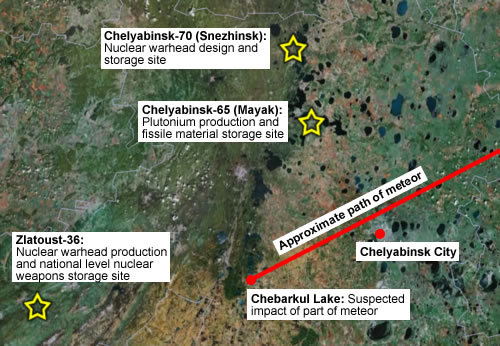
The meteor impacted near large Russian nuclear weapons facilities..
By Hans M. Kristensen
When the news media reported that a meteor had exploded over Chelyabinsk in Russia, the location name sounded familiar: the region is home to some of Russia’s most important nuclear weapons production and storage facilities.
Impact sites still have to be found but one reportedly was Chebarkul Lake, some 72 kilometers (45 miles) southwest of the city of Chelyabinsk. Another piece impacted near the town of Zlatoust some 80 kilometers (49 miles) to the northwest.
Approximately 88 kilometers (55 miles) northeast of Chebarkul Lake is Chelyabinsk-65 (Mayak), a plutonium production and fissile material storage complex. Another 40 miles to the north is Chelyabinsk-70 (Snezhinsk), a nuclear warhead design and storage complex.
Right in the meteor’s path, approximately 115 kilometers (72 miles) southwest of Chebarkul Lake, is Zlatoust-36, one of the two main warhead assembly and disassembly facilities in Russia. Adjacent to the facility is a national-level nuclear weapons storage site.
The odds of a meteor hitting one of these nuclear weapons production or storage site are probably infinitely small, but on a cosmic scale it got pretty close. Just how much damage a direct hit of a sizable chunk of the meteor could have caused is unknown, but the 17-meter (55 feet) meteor reportedly released energy equivalent to nearly 500 kilotons of TNT. That’s roughly the explosive yield of one of the W88 warheads carried on Trident II missiles onboard U.S. ballistic missile submarines.
This publication was made possible by a grant from the Ploughshares Fund. The statements made and views expressed are solely the responsibility of the author.
Satellite imagery has long served as a tool for observing on-the-ground activity worldwide, and offers especially valuable insights into the operation, development, and physical features related to nuclear technology.
This report outlines a framework relying on “Cooperative Technical Means” for effective arms control verification based on remote sensing, avoiding on-site inspections but maintaining a level of transparency that allows for immediate detection of changes in nuclear posture or a significant build-up above agreed limits.
The grant comes from the Carnegie Corporation of New York (CCNY) to investigate, alongside The British American Security Information Council (BASIC), the associated impact on nuclear stability.
Satellite imagery of RAF Lakenheath reveals new construction of a security perimeter around ten protective aircraft shelters in the designated nuclear area, the latest measure in a series of upgrades as the base prepares for the ability to store U.S. nuclear weapons.